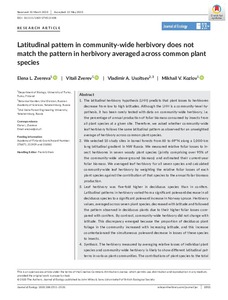Latitudinal pattern in community-wide herbivory does not match the pattern in herbivory averaged across common plant species
Elena L. Zvereva; Vitali Zverev; Vladimir A. Usoltsev; Mikhail V. Kozlov
Latitudinal pattern in community-wide herbivory does not match the pattern in herbivory averaged across common plant species
Elena L. Zvereva
Vitali Zverev
Vladimir A. Usoltsev
Mikhail V. Kozlov
Blackwell Publishing Ltd
Julkaisun pysyvä osoite on:
https://urn.fi/URN:NBN:fi-fe2021042825966
https://urn.fi/URN:NBN:fi-fe2021042825966
Tiivistelmä
- The latitudinal herbivory hypothesis (LHH) predicts that plant
losses to herbivores decrease from low to high latitudes. Although the
LHH is a community‐level hypothesis, it has been rarely tested with data
on community‐wide herbivory, i.e. the percentage of annual production
of foliar biomass consumed by insects from all plant species at a given
site. Therefore, we asked whether community‐wide leaf herbivory follows
the same latitudinal pattern as observed for an unweighted average of
herbivory across common plant species. - We selected 10 study sites in boreal forests from 60
to 69°N along a 1,000‐km long latitudinal gradient in NW Russia. We
measured relative foliar losses to insect herbivores in seven woody
plant species (jointly comprising over 95% of the community‐wide
above‐ground biomass) and estimated their current‐year foliar biomass.
We averaged leaf herbivory for all seven species and calculated
community‐wide leaf herbivory by weighting the relative foliar losses of
each plant species against the contribution of that species to the
annual foliar biomass production. - Leaf herbivory was five‐fold higher in deciduous species than in
conifers. Latitudinal patterns in herbivory varied from a significant
poleward decrease in all deciduous species to a significant poleward
increase in Norway spruce. Herbivory values, averaged across seven plant
species, decreased with latitude and followed the pattern observed in
deciduous plants due to their higher foliar losses compared with
conifers. By contrast, community‐wide herbivory did not change with
latitude. This discrepancy emerged because the proportion of deciduous
plant foliage in the community increased with increasing latitude, and
this increase counterbalanced the simultaneous poleward decrease in
losses of these species to insects. - Synthesis. The herbivory measured by averaging
relative losses of individual plant species and community‐wide
herbivory is likely to show different latitudinal patterns in various
plant communities. The contributions of plant species to the total
foliar biomass production should be taken into account in studies of
spatial patterns of herbivory which test community‐level hypotheses.
This approach may provide new insight into macroecological research on
biotic interactions and improve our understanding of the role of insect
herbivores in ecosystem‐level processes.
Kokoelmat
- Rinnakkaistallenteet [27094]
